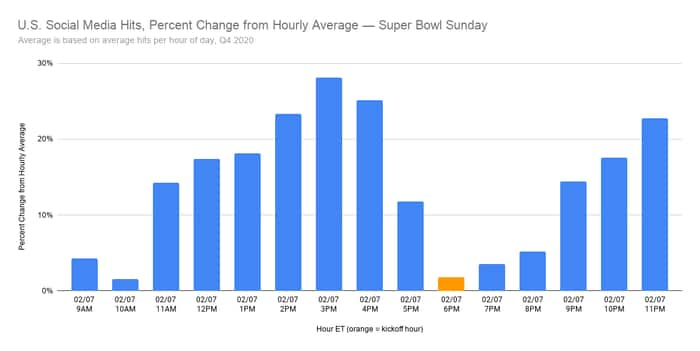Gambling, Social Media, and 10 Years of Streaming the 'Big Game'

Thanks to the unique perspectives we have via the Akamai Intelligent Edge Platform, we're able to observe massive amounts of web traffic and data that provide insights across the various industries Akamai serves. In the wake of Super Bowl LV, we're sharing some observations on gambling traffic and social media activity, two categories that are complementary to the game. We'll also look at how online viewing has increased over the past 10 years of live streaming the big game.
Gambling industry traffic
We took the average daily gambling industry-related traffic for the fourth quarter of 2020 and compared it to daily gambling traffic for 2021 through Sunday, February 7. Overall, we saw a gradual increase in traffic for gambling industry customers leading up to the Buccaneers vs. Chiefs championship game.
The last Sunday of the regular season saw gambling traffic hit 30% over average. On wild-card weekend, traffic was up 23% and 32% on Saturday and Sunday, respectively. The divisional round saw traffic up 29% on Saturday and 35% on Sunday. Gambling traffic was higher on Sunday than Saturday during both weekends that had games on each day.
Interestingly, traffic on the Sunday of the conference championship games and the Sunday of the big game itself was the same, reaching 40% above average. While gambling traffic does appear to increase overall during weekends, game days are notably higher. With no games over the weekend of January 30-31, traffic was still elevated but notably lower than on game days.
%20(1)-thumb-700xauto-12222.png)
Social media activity
We also took a look at aggregated traffic that Akamai delivered in the U.S. for social media customers on that Sunday. In this case, we compared it to the hour-of-day averages for social media traffic that Akamai delivered during the fourth quarter of 2020 to the same hours on the day of the game.
Traffic rose gradually over the course of Sunday until it peaked at 28% above average during the 3 PM ET hour -- roughly three hours prior to kickoff. From there, a fairly steep decline bottoms out at just 1% above average -- essentially even -- at the start of the game.
While it didn't hit its pregame peak, traffic did build throughout the game, reaching 17% and 23% above average during the hours that included the conclusion and post-game celebrations.

10 years of super bowl streaming
February 9, 2021, marked the 10th year that the NFL Championship game has been live streamed. In 2012, NBC Sports was the first to do so, streaming coverage of Super Bowl XLVI to NBCSports.com, NFL.com, and Verizon's NFL Mobile. That year, NBC Sports reported that they streamed 78.6 million total minutes to an average of 346,000 viewers per minute.
This week, Super Bowl LV rights holder CBS Sports announced it streamed more than 1 billion total minutes to an average of 5.7 million viewers per minute. Audiences watched across a host of connected devices and numerous streaming services and platforms, many of which didn't exist in 2012.
Of the exhaustive amount of streaming-related metrics that are available, only one -- average viewers per minute -- has been publicly reported for every live-streamed Super Bowl to date. That said, it's a good one, which demonstrates the uptake of streaming over the past 10 years, per the graph below.
-thumb-700x433-12227.png)
We can see a fairly gradual increase in average viewers per minute over the first nine years of live streaming Super Bowls; then we get to the 68% jump from 2020 to 2021. It's reasonable to deduce that the marked increase between 2020 and 2021 is largely due to two factors: First, COVID-19 kept many viewers in their individual homes instead of gathering at bars/restaurants and parties. Also, options to stream the game were widely available, including "CBS Sports and NFL digital properties, via CBS All Access, and on mobile via the participating teams' mobile properties, Yahoo Sports and other Verizon Media mobile properties," according to CBS Sports. Viewers also had options through several streaming services, such as Hulu Live, YouTube TV, and FuboTV.
Conclusion
Though traffic fluctuated in the case of gambling and social, it did so at levels that remained well above average in these windows. And it looks as if more viewers than ever live streamed the Super Bowl. While people gambled with their money, they didn't with COVID-19. Instead, they stuck around their homes, streamed the game, and did their interacting via social media.
Average viewers per minute sources:
http://nbcsportsgrouppressbox.com/2012/02/07/super-bowl-xlvi-live-stream-sets-traffic-records/
https://www.cbspressexpress.com/cbs-sports/releases/view?id=44573
http://nbcsportsgrouppressbox.com/2018/02/05/53820/
https://www.cbspressexpress.com/cbs-sports/releases/view?id=51928
https://www.viacomcbspressexpress.com/cbs-sports/releases/view?id=56937




